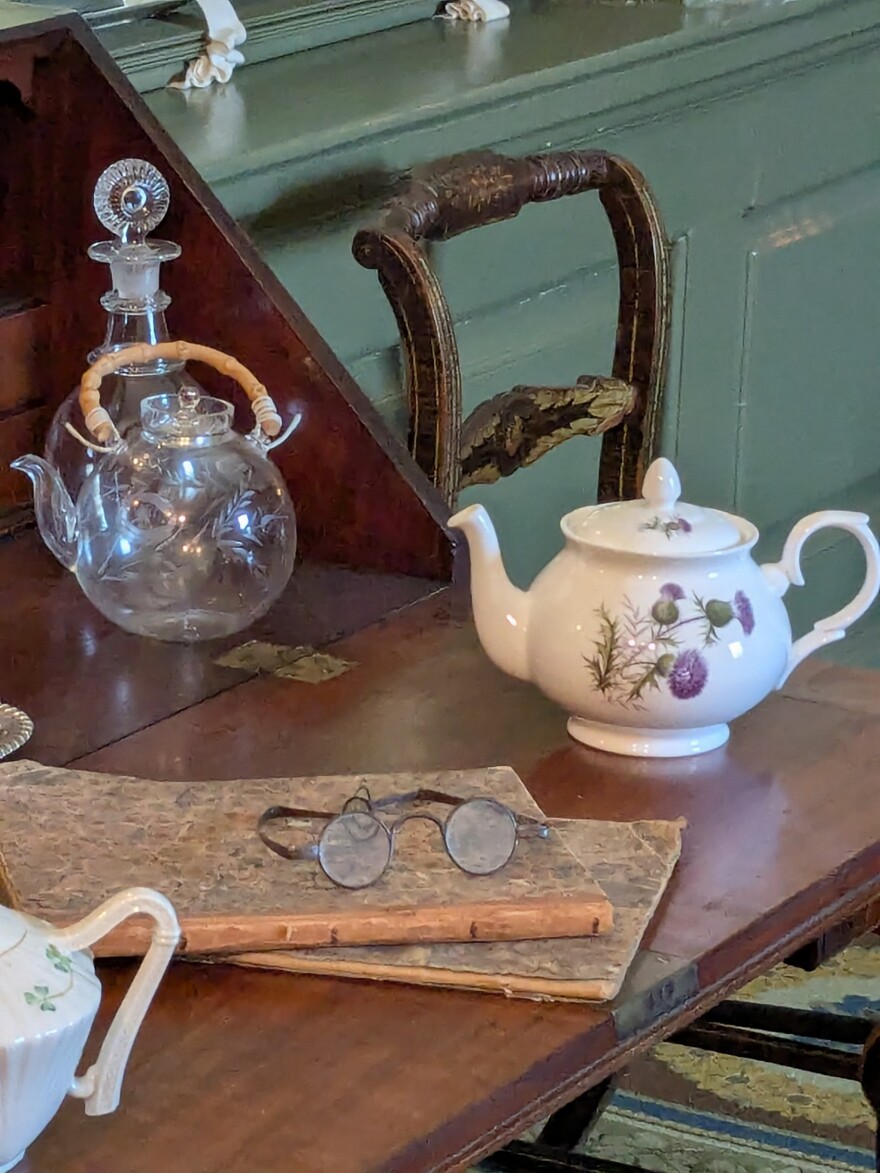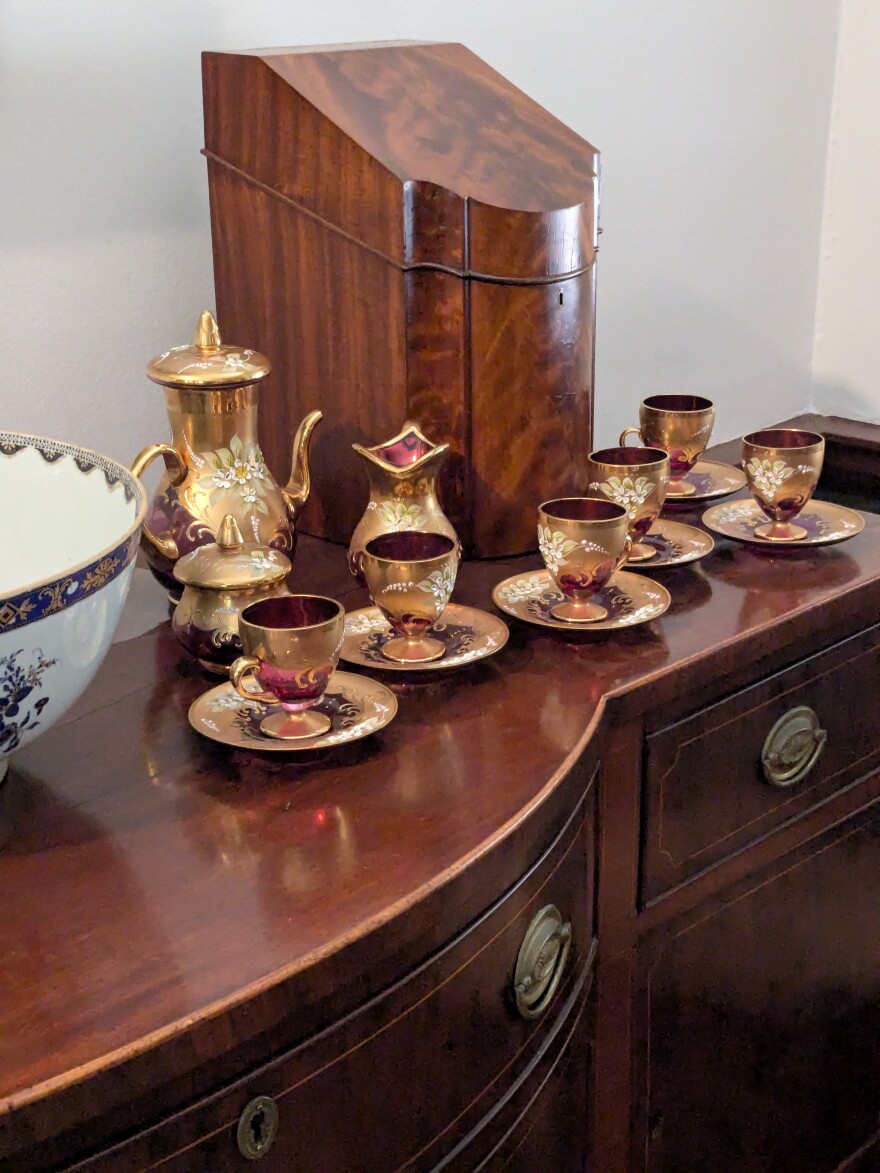It’s a hot summer morning in Odessa, but inside the historic Wilson-Warner House, the hallway is dark and cool. I’m here to look at the myriad ways craftspeople over the years have turned their artistic talents to one of the most common of objects - something most of us have in our homes.
I’m here to look at teapots. Lots and lots of teapots.
“There are nearly 250 objects but teapots alone, nearly 200,” says Brian Miller, Associate Curator at the Historic Odessa Foundation and my tour guide for an exhibition he curated.
“I went back and forth on the title of the exhibit,” Miller says. “The exhibit is called ‘My Cup of Tea.’ I was going to even think of possibly naming it something like, you know, ‘I'm a little teapot, short and stout,’ or, you know, something related to that sort of rhyming story. But I think this title, in the end, really captures the collector.”
They're not all little, short, or stout, but I can verify from firsthand experience that all the teapots I saw did, in fact, have a handle and spout.
But before we get to looking at the array of teapots, I want to go back to one thing Brian Miller just said - “the collector.”
Because every one of the 250-plus objects on display comes from one person’s collection.
“A friend of mine said, ‘ Wow, I know this lady who has this wonderful collection of teapots. Would you ever want to show it at the museum?’ Miller says. “And I was like, ‘wow!’ So it took a little while, but eight months later, I was invited to the collector's house. I looked at the teapots, took pictures, and we definitely wanted to show them for a summer exhibit here in the Wilson-Warner House.”

Each of the rooms in the house is filled with teapots, grouped thematically, Miller explains. To start our tour, we head into the parlor, where he has put out a display of English teapots, and here is where one of the few things I know about teapots pops up - Wedgewood.
“Right here in the parlor of the Wilson Warner House, we have a wonderful collection of Jasperware teapots. And they are the Wedgwood brand, made right in London. They're just really well known for the wonderful shape, the colors, and the sort of unusual matte finish that's on the outside,” Miller says.
A round table in the center of the parlor is loaded with Wedgwood teapots in lots of different colors - orange, red, green, black. And on the table I spot something else Wedgwood is known for - a beautiful shade of blue - maybe a little darker than sky blue.
“It's good that you notice the lighter blue,” Miller says.”That's actually even - not necessarily copyrighted - but it's known as the Wedgwood blue.”
And, over by the parlor wall, he points out one of his favorite parts of the exhibition.
“The little grouping that's right on the desk representing the United Kingdom,” he says, pointing out the collection of teapots, flanked by other small antiques, like a pair of glasses. “So we have Ireland, Wales and Scotland represented with a teapot from each location.”

The Irish teapot, as you might expect, is covered with delicate shamrocks. The Welsh teapot, as if determined not to be overlooked, is an explosion of color.
“That's called a gaudy Welsh teapot. So it has a sort of orange and blues and greens and a lusterware sort of finish of the glaze,” Miller explains.
And joining Ireland, Scotland, and the very insistent Welsh example is a piece from a place that used to be British - the US. Unlike many of the other teapots I’ve seen, this one is glass, a deep green, an elegant, swooping shape.
“The collector found that one, and I think saw actually it hand blown in Colonial Williamsburg,” Miller says.
Moving across the hallway to the dining room, I’m struck by what would be my favorite part of the whole exhibition - two large cupboards filled with Art Deco and mid-century modern teapots. They come in all colors of the rainbow, and their forms are sleek and modern-looking.

“They're called ‘Streamlined’ and the coolest thing is they're made along the Ohio River,” Miller says. “And I noticed that the collector had collected the most of this style. So this is really her favorite. She loves the 1930s, the 1940s.”
Also in the dining room, on a sideboard along the wall, is a collection of exquisite cups, saucers, and of course teapots, all a brassy metallic color. In fact, at first, I think they’re made of metal. Miller sets me straight.
“Yes, definitely glass,” he says. “And covered with three-dimensional flowers. And I think possibly it's 24 karat gold.”
Miller tells me these are special - part of a world-famous glassmaking tradition that dates back some 800 years.
“All made by the Murano glass factory in Venice, Italy,” he explains. “The collector was there with her husband on a few different occasions vacationing, and they picked up different sets on their visits.”

Our tour continues - into the kitchen which is dedicated to Russian and Asian pieces, and into the master bedroom upstairs where Miller has grouped pieces related to domestic life and the feminine. And, across the hall, a fun collection in the kids’ room.
“I picked ones that kids would be able to relate to when they go into that room. There's one in the shape of a blimp, two that are in the shape of cars of the time period. Also, there's one that's made of a coconut,” Miller says as he shows me around. “There's one that's shell-shaped, and a couple that have children on them, the Hummel sort of style with little children, and even two that are from the world's fair.”
Back downstairs in the dining room, Miller explains that the strength of this exhibit is its diversity.
“The coolest thing with this exhibit is the teapots cross all cultures, times and places. So we don't just have English or American teapots, but there are Russian related things. There are Asian related things, European. So it's really a wonderful collection to see all together,” he says.
We’ve talked a lot about teapots as art, and of course their practical use is apparent as well. But there’s another purpose to the humble - or not so humble in some cases - teapot. In the days before smartphones, fancy cars, and infinity pools, a teapot was also a status symbol.
“It has lots of roles. It can show the status of the owner. It could show the taste of the owner. It could show if you're a common person, if you're a more wealthy person. It can show a lot. And I think this collector has really shown that also,” Miller says. “It's just amazing to see them all together, isn't it?”
And regardless of what you think about teapots as art or status symbols, there’s one other thing the teapot does - it brings us together, as it has for centuries.
“It's a whole social thing where neighbors and friends would get together, sit around the tea table, talk about their travels, talk about religion, talk about politics, talk about neighbors, and by the way, it's not just for women. It's for everyone,” Miller says.
You can think about these teapots not as artifacts, but as a thread running through history, connecting people like us with, well, people like us over the years.
“I think they'll be able to identify with them because basically everyone should have some kind of a teapot, coffee pot, whether it's sitting on their stove, it's sitting in their kitchen or living room or whatever,” Miller says.
And that brings us squarely back to the dark, cool hallway at the Wilson-Warner House, and to the title of this exhibition, “My Cup of Tea.”
“I'm hoping that a little girl or a little boy or someone will just really be able to identify with a wide variety of teapots and find one that they just really love,” Miller says.
In short, their cup of tea.




